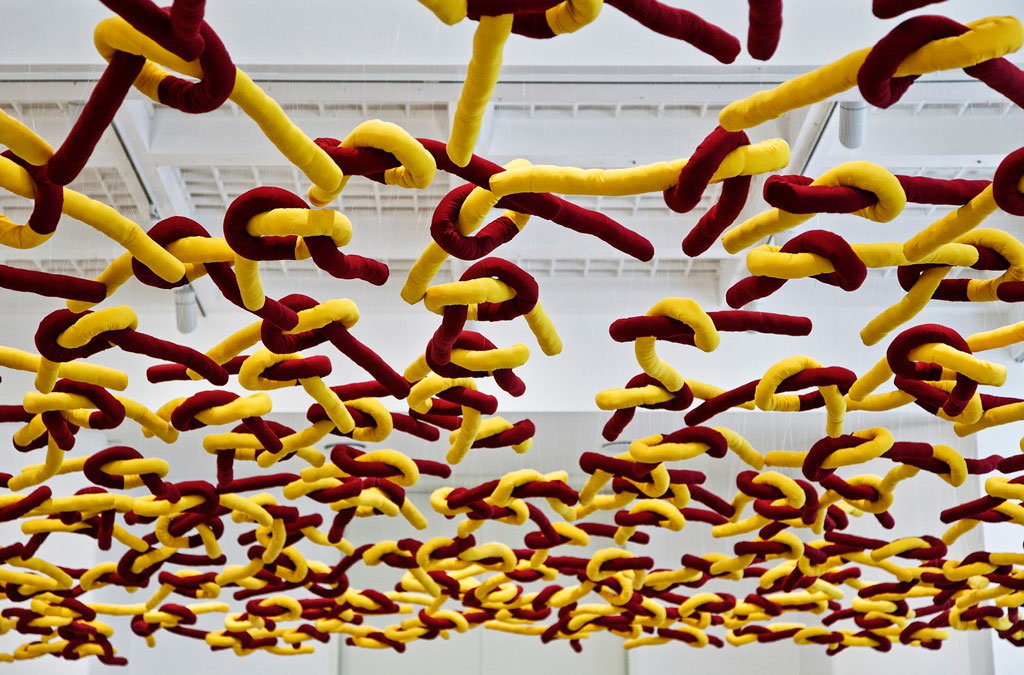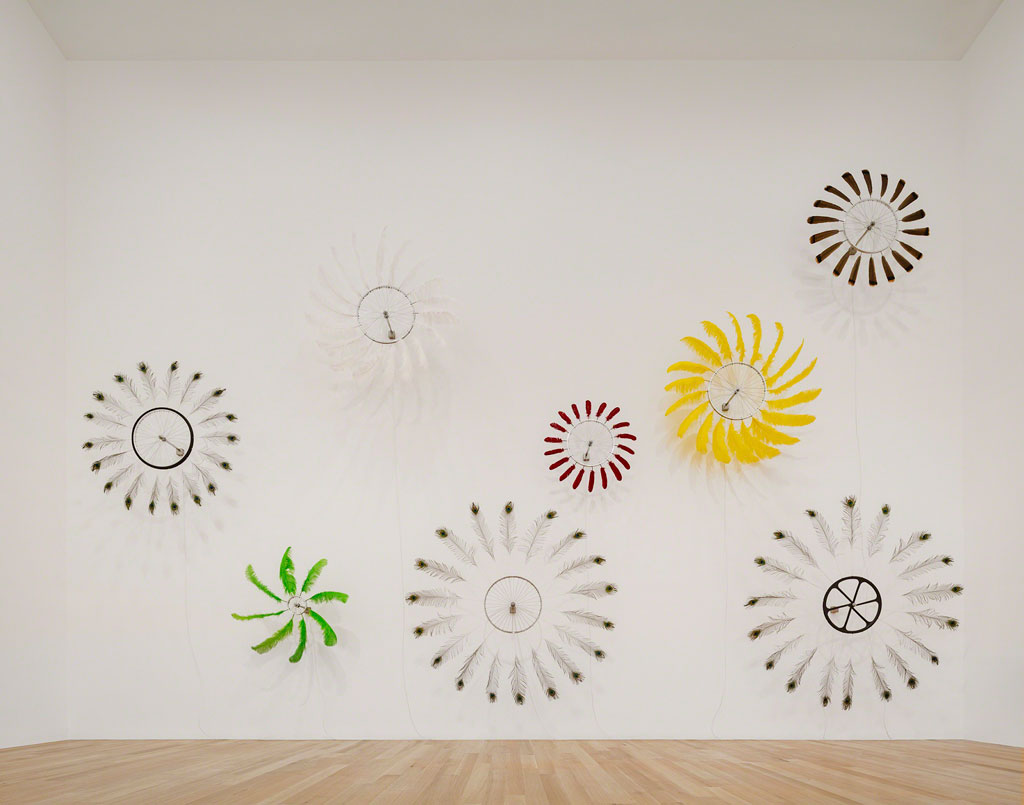ART CITIES:Rome Paola-Pivi
 Paola Pivi’s works are authentic experiences of wonder, enterprises that mould and personalise the context surrounding them, transforming it into a pure artistic moment, imaginative and unexpected, generating and affirming new and impossible realities. Constructing situations at the limit of the surreal through simple but decisive gestures and titles as ironic as they are paradoxical, Paola Pivi creates her personal version of reality, “reality, not realism” as she tends to point out, claiming the right to play with the world and allow her art to be experienced for that which it is, without stories or references, like any fragment of quotidian existence.
Paola Pivi’s works are authentic experiences of wonder, enterprises that mould and personalise the context surrounding them, transforming it into a pure artistic moment, imaginative and unexpected, generating and affirming new and impossible realities. Constructing situations at the limit of the surreal through simple but decisive gestures and titles as ironic as they are paradoxical, Paola Pivi creates her personal version of reality, “reality, not realism” as she tends to point out, claiming the right to play with the world and allow her art to be experienced for that which it is, without stories or references, like any fragment of quotidian existence.
By Dimitris Lempesis
Photo: MAXXI Archive
Conceived specifically for the spaces of Maxxi , Paola Pivi’s exhibition “World record” presents the imagery of an artist who, through her works, gives life to a new form of reality, ironic and exaggerated, composed of intense contrasts, overwhelming gestures, objects taken from our quotidian existence which acquire a new role, demonstrating other possible ways of interpretations of meaning. Whether they are colossal or minuscule pieces, the engaging works of Paola Pivi change the spirit of the place housing them and activate the senses of visitors, subverting the classical confines between public space and intimacy. The exhibition layout begins under a vast grid of hundreds of soft, intertwined forms suspended in mid-air: “Share, but it’s not fair” (2012), a work composed of yellow and red cushions, made with the fabrics of Tibetan monks’ tunics, forms an abstract and simultaneously three-dimensional pattern. “The title is like the lament of a child obliged to share an ice cream when he really didn’t want to”, says the artist, “Walking under the great expanse of cushions is enchanting, it’s like exploring a magical world”. The work that gives the title of the exhibition “World record” (2018) is a new architecture contained within the museum’s architecture, is at the same time installation, sculpture and inhabitable space. It interacts with the surrounding space and the audience by offering a friendly way of discovering another dimension. This gargantuan, absurd project is yet another way for the artist, who always tries to overcome the limits of the possible, to challenge the way imagination can be rendered concrete. In spite of its size, the artwork maintains a feeling of playfulness, in fact it presents two seas of mattresses, that are separated by a gap of a few feet, a space, which the visitors are invited to explore and activate with their gestures. The laws of space and gravity seem subverted at times. The artwork offers a new point of view on the world by creating an unconventional space that is not high enough for standing, but rather forces the audience to lie down, roll over or crawl. By triggering unusual, playful, carefree and emulative behaviours, the artwork allows the visitors to have fun and establish unexpected interactions. The representation of the interaction between the human and the animal world is a recurring feature in the artistic research of Paola Pivi, who has been living in Alaska, a land where the dialogue between man and nature is authentic, since 2006. “Did you know I am single?” (2010) is reminiscent of the typical hunting trophy, the bearskin, but it is made of synthetic fur, as if the artwork were the result of a paradoxical game. By using a synthetic material other than the original, the artist enables the object to take on a meaning that is different from that of a real fur carpet, which is a metaphor for the supremacy of man over nature: the reference to stuffed toy animals makes this artwork ironic and playful, while maintaining its melancholic and dramatic side. On the other hand, the artwork provokes the sense of wonder evoked by the taxidermy animals presented as case studies in 19th-century natural history museums. Despite the synthetic materials used, there remains a sense of familiarity between the audience and the bearskin, which seems to have been just removed from a wall above a fireplace. This image, sometimes a status symbol, is part of the collective imagery. Almost as if to close a symbolic temporal short circuit, one of the very first works created by the artist is also on show: “Scatola umana” (1994), a cubic sculpture in Plexiglass just 10 cm per side that, with the benefit of hindsight, seems to contain all the creativity of the artist, then freed to the full extent of its expressive power through a multitude of forms, dimensions and media. “Very fuzzy” (2019) is part of a series produced by the artist starting from 2016, exhibited for the first time at Dallas Contemporary in Dallas. Bicycle wheel spin at constant speed while hanging on the wall, decorated with various kinds of feathers, thereby creating a hypnotic effect. These kinetic artworks create a wave with the movement of the feathers and remind us of large rotating dreamcatchers. The choreography of the feathered wheels seems conceived for a carnival party. It generates a playful but silent atmosphere, that hinders the perception of the passing of time. “Share, but it’s not fair” (2012) is an intertwining of hundreds of cushions hanging in midair, resembling a fluctuating, delicate embroidery, made of knotted soft shapes that create an abstract, three-dimensional motif. All the cushions are red and yellow, made with the fabrics of the robes of Tibetan monks. The intertwining of the single cushions, the precariousness of the hang made by very tiny threads, the lightness, the multiplication and the seriality form a community, where the relationship among the single and the other elements is unique for each of them and at the same time similarly repeated for all of them. “Untitled (gold sofa)” (1999): the works, produced between 1998 and 2001, testify to the emergence of design in the Italian art of the ‘90s. They consist of accurate miniature reproductions of sofas that are soaked in perfume, which dilates their presence into space and makes them more precious. The artworks, with their dripping liquid, undergo over time a metamorphosis of their appearance, which is at the same time ironic and seductive. Paola Pivi’s sofas cease to be intimate, personal, familiar pieces of furniture symbolising comfort and routine and become precious collector’s items. They lose their functionality, but keep their formal look. The space occupied by the artwork is modified by its change in scale, which, direct and sharp, reveals the playfulness of the artist’s mind.
Info: Curators: Hou Hanru and Anne Palopoli, MAXXI, Via Guido Reni 4A, Rome, Duration: 3/4-8/9/17, Days & Hours: Tue-Fri & sun 11:00-19:00, Sat 11:00-22:00, www.maxxi.art












